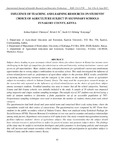Influence of Teaching and Learning Resources On Students’ Choice of Agriculture Subject in Secondary Schools in Nakuru County, Kenya

View/
Date
2017Author
Cheruiyot, Joshua Kipkorir
Kibett, J. K
Konyango, Jacob J.J. Ochieng’
Metadata
Show full item recordAbstract
Subject choice leading to post secondary school career choice for school leavers in Kenya has become more challenging in the light of competition for admissions to relevant University, tertiary institutions’ courses and access to job opportunities. Many students miss relevant placement for agricultural courses and employment opportunities due to wrong subject combinations in secondary school. This study investigated the influence of school-related factors such as; performance of agriculture subject in the previous KSCE results, availability of teaching and learning resources and the category of the school on the students’ choice of agriculture subject in secondary schools in Nakuru County, Kenya. The study used the ex-post facto research design, as the researcher only reported on the influences of school-related factors on the choice of agriculture subject among secondary students. Stratified sampling was used to ensure that all the school categories; National, County and Sub County schools were initially included in the study. A sample of 18 schools was employed using purposive andsimple random sampling technique. The sample size of 367 students was derived using a table of random numbers to determine a finite population out of an accessible population of 7955. Proportionate sampling techniques were used to determine the number of students drawn from each schoolcategory. The questionnaires had both closed and open ended items and comprised likert scale rating items, where the respondents would tick their points of concurrence. The questionnaires were completed by 367 Form three students in the public secondary school of Nakuru County. Data was analyzed using Statistical Package for Social Sciences (SPSS). Pearson Moments Correlations (r) test was used to examine and analyze relationships among study factors. Hypotheses were tested at 0.05 alpha levels. The study revealed that agriculture learning facilities influence students’ choice of agriculture subject. The study recommended that the subject should have relevant resources and facilities to reflect its practical nature and promote subject choice. The findings of the study may be useful to curriculum developers and policy planners in developing policies and strategies that will increase and sustain secondary school students’ interest and participation in agriculture subject in Nakuru County and the entire country, Kenya.
